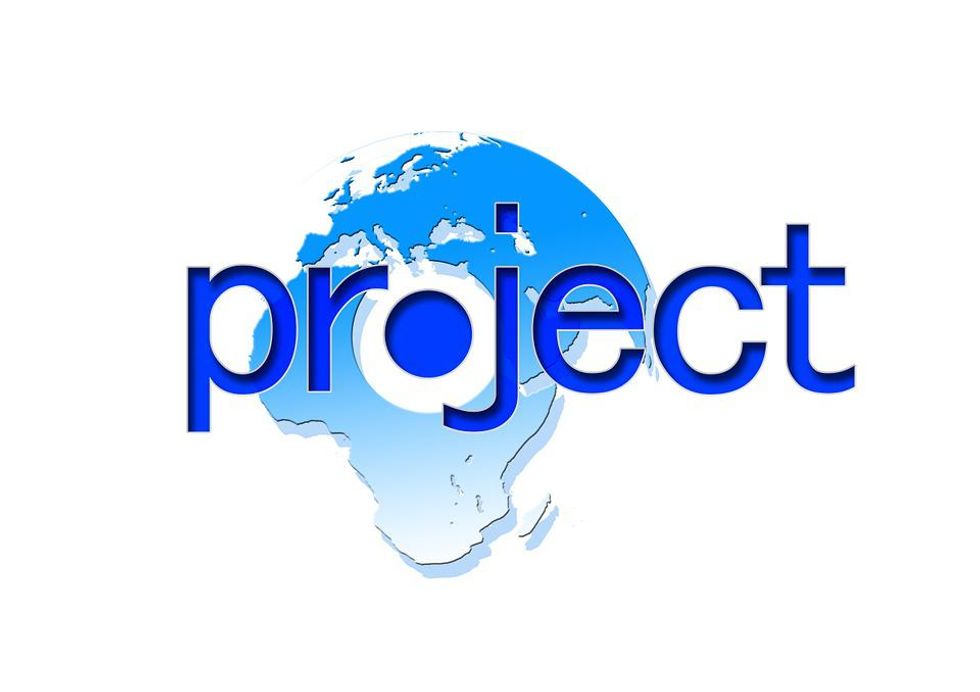
Are you in a race against time to get everything you can possibly get done in this lifetime?
Do you have a bucket list of things to do that you never seem to complete? Are you unaware just how much all of your bucket list will cost or how you will actually complete each item?
In this article, I present a simple, 8-step process to transform both your bucket list and other life goals or projects into what I call the project life roadmap. The idea is to help you gain control of and better manage the projects in your life by incorporating project management techniques, with the aim of also helping you to improve your overall quality of life.
The Case To Replace Your Bucket List With A Project Life Roadmap
 Project Earth Globe - Free image on Pixabaypixabay.com
Project Earth Globe - Free image on Pixabaypixabay.comI do not know about you, but I myself have so many interests and goals to achieve that I always feel like I am in a race against time to be able to get it all done.
I have used bucket lists in the past, but have found that they end up being a collection of nice to have things, or crazy adventures to do while I am still able to, rather than an integral part of who I am.
The other thing that I have seen frequently is when we have not really thought through each item on the list and this can bring surprises such as higher than expected costs, inflexible date ranges, or unexpected requirements, just to name a few.
What if we were to apply a project management lens to these life goals and couple them with our bucket list items to create a common list of our goals, interests and must-have experiences in order to enjoy life to the fullest?
Step 1: Creating Your Life Project (Scope)
 Teacher Cartoon Board - Free image on Pixabaypixabay.com
Teacher Cartoon Board - Free image on Pixabaypixabay.comStep one in the process of creating your project life roadmap consists of defining the top level categories of your projects and then determining the scope of each one. The scope is basically all of the elements, features, or outputs that will be completed as a result of the project.
When scoping your projects, be as specific as possible with the outcomes (deliverables) you expect for each one. Be careful not to be too open-ended as you will then be unable to determine if or how successful you were on each endeavor. Plus, it will make it difficult for you to set an appropriate budget or time scale.
I categorize my life projects into five categories: academic, work, travel, sport or leisure, and family projects. The aim, of course, is to help me strike an acceptable work-life balance by having personal projects along with my professional ones in one convenient roadmap.
For this article I have chosen an example of one of my life projects which was to travel to all of the continents by the age of 30.
The scoped items here were the list of the continents, the selected countries and cities I wanted to visit in each one, along with the photos, souvenirs, music, videos, and books acquired during these trips.Step 2: Set Start And End Dates For Each Project (Time Management)
 Close-up Photo of Calendar · Free Stock Photowww.pexels.com
Close-up Photo of Calendar · Free Stock Photowww.pexels.comOnce your projects are scoped, you are now ready to assign the time elements to each one.
In this step, it is important to create a schedule by mapping the scoped deliverables for each project so that start and end dates are applied to each one.
For example, on my travel project, the dates were aligned with each destination so I could understand how many trips I would need to take as well as when I would have enough time to take each one, once again considering my budget and vacation time constraints.
For your plan, ensure there is some buffer in the individual time targets to account for possible risks, personal issues, or things beyond your control such as a storms, natural disasters, or political crises, unless there are hard dates to consider (i.e., the dates of the Summer Olympics).
It will also help you to know when certain costs are due as well as any important milestones that you will need to be prepared for such as registration deadlines, consular interviews, or doctor's appointments.Step 3: So What's This Going To Cost Me? (Cost And Quality)
 File:Money Cash.jpg - Wikimedia Commons
File:Money Cash.jpg - Wikimedia CommonsSource: Wikimedia Commons
It appears obvious that we need to always budget our expenses in life; however, I am always surprised at the number of people who seem to be aware of what they are spending, yet get completely surprised when the bills come in.
For this reason, a detailed budget is crucial to manage your spending.
For my Travel Project, I calculated my budget based on all of the expenses, identified and hidden, so that a worst case scenario budget was created. Possible quality variants were traveling in first class or economy, single or with someone, as well as staying in a 3- or 4-star hotel, etc.
Whatever the case may be, identifying all associated expenses is vital in preparing yourself for the total cost of your life project.
Due to unforeseen events on my travel project such as currency fluctuations, non-acceptance of foreign currencies or even credit cards, I had to have a contingency stash of money to cover these eventualities.Step 4: What And How To Buy For My Life Project (Resource And Procurement)
 Online Shopping Ecommerce - Free photo on Pixabaypixabay.com
Online Shopping Ecommerce - Free photo on Pixabaypixabay.comIn this step, you will use your cost budget to prepare a list of all of the required resources you will then need to purchase for your project.
Make sure this list is as complete as possible and it will also be determined by your budget, of course. For me, the issue was more of what I would not be able to find on my trip, the potential high cost of buying a like for like item, or any specific items which may be prohibited in the destination country.
So, in order to optimize the budget you have, make the time to identify all of the providers or sources that can supply each item you will need as well as when and where each item can be purchased, the purchase price, delivery time, and technical details for important things such as plug adapters, SIM cards, or other items which may require specific configurations depending on the destination or use.
Again, the notion of quality comes into play and you will need to decide what standard you are willing to accept and how much you can afford for each item.Step 5: Identify Potential Risks (Risk Management)
 CAUTION | Henrique Pinto | Flickrwww.flickr.com
CAUTION | Henrique Pinto | Flickrwww.flickr.comIn this step, you list all of the possible risks that could impact your life project. You then assign a low, medium, or high level value to each one and then sort them by level of risk.
Be sure to list as many possible risks that you can think of, give them a stoplight color, and then calculate an overall average or risk color for each project.
Each person has their own risk tolerance so you may be very comfortable with high risk projects whereas others may be much more risk averse. Be sure you understand your personal risk tolerance level and ensure that each of your projects does not exceed this level, unless, of course, you take the conscious decision to explore outside your comfort zone.
As I was planning my travels, the selection of the countries to visit was predicated on the risk level I associated with each one. The risks were not only the safety risks involved, but also the political stability, specific local laws, currency fluctuation, mobility in country, potential visa issues, and food variety, just to name a few.
My advice to you when you apply risk management to your life projects is not to be overzealous to the point of becoming paranoid. We cannot remove all risks from our lives; however, by mapping them out, we can definitely reduce our anxiety and focus on enjoying the experience!
Step 6: Understand Communication Options (Communications Management)
 487093020 | close up of school kids playing with tablet pc ...www.flickr.com
487093020 | close up of school kids playing with tablet pc ...www.flickr.comHave you ever stopped to think about the best way to ask for a personal bank loan, approach customer service when returning an item, or requesting a specific table in a restaurant?
Having a communication plan can greatly help you navigate these scenarios.
When you put your communication plan together, be sure to list:
- all of the people involved in your project
- preferred method and frequency to communicate with each person
- identify any formal communication such as documents or contracts that will have to be provided
There are definitely cases where written communication is required so be sure to understand fully any specific requirements such as forms to be filled out, originals, stamps, etc.
When I completed my world tour in the late 1990s, there was little internet, no Google translate, very limited cell phones, and expensive, complicated international telephone calling options. The information available at the time was mainly through guide books I purchased through travel agents or in bookstores, along with advice I got from friends and colleagues. This in itself added to the novelty for each trip, with also quite a few interesting situations as you can imagine!
Step 7: Who Will Support Your Project? Any Detractors? (Stakeholder Management)
 Identify The Key Stakeholders
Identify The Key StakeholdersWhen you stop and think about it, the number of people and organizations, also known as stakeholders, who could be involved on your project can be quite a significant number.
With all of these variables comes differences in personalities, business practices, cultures, and laws which could put you in certain situations in which you will need to understand the degree of influence as well as support that each of these people have for your project, for they could have a significant impact on your project. Be aware of potential surprises here should you misread someone's intentions or level of influence!
Make sure you:
- list all of the stakeholders involved in your project
- place them in friend or detractor buckets
- indicate the level of influence that each stakeholder would or should have
Be sure to tailor your communication strategy to deal with each one per Step 6.
When traveling, I could easily think of the many people such as travel agents, taxi drivers, airport agents, customs, border control agents, restaurant servers, tour guides, museum staff, equipment rental staff, foreign police, other tourists, monument curators, my company, and travel companions who could affect my project.Step 8: Wheeling And Dealing (Integration Management)
 Miniature man looking at a missing puzzle piece with Solut… | Flickr
Miniature man looking at a missing puzzle piece with Solut… | FlickrNow it is time to bring all of the aspects of your life project together which can oftentimes lead to conflicts such as competing resources or some kind of constraint to be managed.
This is where even the best laid plans will be tested as you will no doubt be required to:
- make trade-offs either in the level of quality
- pursue a Plan B scenario or re-scoping your project due to some unforeseen circumstance
- respond to the game of life itself
On my travel project, this happened to me on more than one occasion and I was forced to choose which country to visit or drop due to time constraints, evaluate the impact caused by a last minute change in governmental policy which now required visas for foreigners as well as alternate transportation methods when the sea borders were closed midway through one of my trips.
Competing projects can also require review and reallocation of the budget or even postponement.
When projects collide, we are forced to negotiate solutions which will then require that we 1) identify what we wish to gain, 2) what we are willing to give up, and 3) identify our minimum acceptable criteria for acceptance. After all, most negotiations are predicated on this concept so be realistic enough to realize that you will probably not get everything you want without having to sacrifice something.
Transforming my bucket list and goals to the roadmap format definitely helped me put my life in perspective and I feel like I have lived life to the absolute fullest on a daily basis ever since!
- How I Used Project Management To Excel In Life - Work It Daily ›
- How Project Management Solved A Crisis Early On In My Career ... ›
- The Important Steps Toward Achieving Data Governance - Work It Daily ›
- How To Navigate Strategic Roadmaps In Business - Work It Daily ›

 Bigstock
Bigstock Bigstock
Bigstock Bigstock
Bigstock


